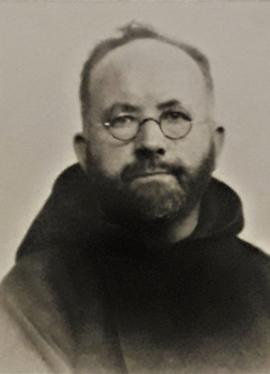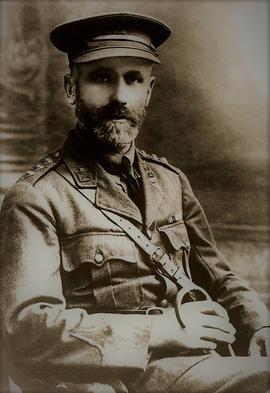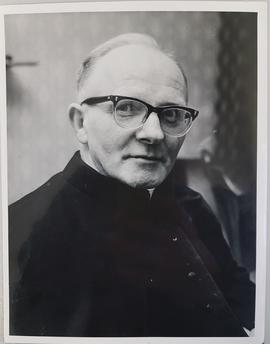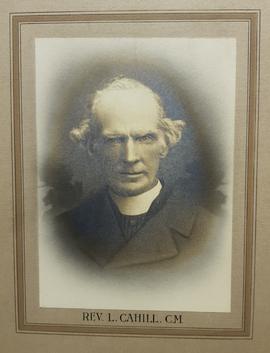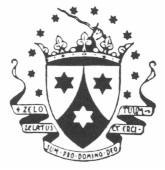Baptismal name: John Butler
Religious name: Br. Colman Butler OFM Cap.
Date of birth: 28 Feb. 1890
Place of birth: Kilgreana, Rosslee, County Mayo
Name of father: Edward Butler (Farmer)
Name of mother: Margaret Butler (née Flannery)
Date of reception into the Capuchin Order: 17 Dec. 1922
Date of first profession: 10 Feb. 1924
Date of final profession: 10 Feb. 1927
Date of death: 1 Dec. 1958
Place of death: Kilkenny County Hospital (now St. Luke’s General Hospital)
Place of burial: Foulkstown Cemetery, County Kilkenny
Patrick Butler was born in Sheastown, County Kilkenny, on 6 February 1873. He joined the Capuchins in 1890 (taking John as his religious name) and was ordained a priest in January 1899. For the following three years he worked as a science teacher in the Capuchin College in Rochestown, County Cork. He subsequently joined the missionary staff and was involved in giving missions and retreats throughout Ireland. In 1914, he travelled to Harrisburg in Pennsylvania. He spent nearly two years in the United States assisting Irish Capuchin missionaries in preaching activities. Following the outbreak of the First World War, he returned to Ireland, and in April 1916 was appointed a chaplain in the British Army with the rank of Captain. He served for a short time with the home garrisons in Canterbury and in Blackpool. He was later sent to the Middle East and Palestine as part of the Egyptian Expeditionary Force (EEF), an Allied military formation which fought the Ottoman Turks for control of this strategically important region. He was present at the Battle of Gaza (March 1917), and at the capture of Jerusalem (December 1917), and later acted as chaplain in a casualty clearing station in Damascus. Fr. John returned to Ireland in 1919 and spent the following eleven years in the Capuchin Friary on Church Street in Dublin. In 1930 he moved to Cork and was attached to the community at Holy Trinity Friary. He remained in Cork until his death on 3 October 1950.
Baptismal name: John Butler
Religious name: Fr. John Butler OFM Cap.
Date of birth: 6 February 1873
Place of birth: Sheastown, County Kilkenny (Diocese of Ossory)
Name of father: Tobias Butler
Name of mother: Catherine Butler (née Murphy)
Date of reception into the Capuchin Order: 23 June 1890
Date of first profession: 15 Aug. 1891
Date of final profession: 11 Oct. 1896
Date of ordination (as priest): 8 Jan. 1899
Missionary activity: Travelled to Harrisburg, Pennsylvania, United States on 18 May 1914; Returned to Ireland on 25 Mar. 1916.
Educational attainments: BA (RUI)
Date of death: 3 Oct. 1950
Place of death: Cork
Place of burial: Cemetery, Rochestown Capuchin Friary, Cork
Note: Fr. Casimir Butler OFM Cap. (1876-1958) was a younger brother of Fr. John Butler OFM Cap.
William Byrne was born in Enniscorthy, County Wexford, on 6 July 1887. He joined the Capuchin Franciscans on 23 May 1908 and took Aidan as his religious name. He made his solemn profession on 12 October 1912. For many years he was associated with the House of Studies at St. Bonaventure’s in Cork. He was later appointed a Brother Questor and collected alms to support the friars for over twenty years. He died in Dublin on 1 June 1963 and was buried in the Capuchin plot in Glasnevin Cemetery.
Baptismal name: William Byrne
Religious name: Br. Aidan Byrne OFM Cap.
Date of birth: 6 July 1887
Place of birth: Duffy’s Gate, Enniscorthy, County Wexford (Diocese of Ferns)
Name of father: Edward Byrne (Painter)
Name of mother: Mary Byrne (née Atkins)
Date of reception into the Capuchin Order: 23 May 1908
Date of first profession: 8 Sept. 1909
Date of final profession: 12 Oct. 1912
Date of death: 1 June 1963
Place of death: Bons Secours Hospital, Glasnevin, Dublin
Place of burial: Glasnevin Cemetery, Dublin
James Cahalan was Provincial of the Irish Vincentian Province 1966-1975.
Baptismal name: James Alan Cameron
Religious name: Br. Peter Cameron OFM Cap.
Date of birth: 16 Oct. 1930
Place of birth: Liverpool, England
Name of father: Thomas
Name of mother: Anna
Date of reception into the Capuchin Order: 31 Oct. 1964
Date of first profession: 1 Nov. 1965
Date of final profession: 1 Nov. 1968
Date of death: 18 Mar. 1985
Place of death: Ard Mhuire Friary, County Donegal
Place of burial: Cemetery, Ard Mhuire Friary, County Donegal
Francis Cantillon was born near the village of Glounthaune in County Cork on 20 June 1880. He attended the local diocesan seminary for several years, but after some discernment entered the Capuchin novitiate in September 1899. Having completed his philosophical and theological studies, he was ordained on 16 March 1907. In 1910 he was appointed guardian (local superior) of the Capuchin friary in Kilkenny. Following the completion of his term as guardian, he engaged in the ministry of preaching missions and retreats throughout Ireland. He was transferred to the United States in 1926 and took up residence in Mendocino County in California. Later that year he assisted Fr. Thomas Dowling OFM Cap. in ministering in Visitation Valley near San Francisco. This assignment was a temporary one as within a few months the Irish friars were given the administration of the new parish of Our Lady of Angels in Burlingame, California. They resided there in a small house on Cortez Avenue. In 1931 Fr. Berchmans was appointed Pastor of Our Lady of Angels parish in Ukiah, a position he filled until 1937 when he took up the position of pastor of the church of St. Francis of Assisi in Bend, Oregon. His health began to decline in subsequent years, and he retired from active ministry in 1940. He moved to Los Angeles and died there on 12 March 1942. He was laid to rest in the Capuchin plot in Calvary Cemetery in Los Angeles.
Baptismal name: Francis Cantillon
Religious name: Fr. Berchmans Cantillon OFM Cap.
Date of birth: 20 June 1880
Place of birth: Rockfarm, Glounthaune, County Cork
Name of father: Denis Cantillon
Name of mother: Mary Ellen Cantillon (née Mahony)
Date of reception into the Capuchin Order: 8 Sept. 1899
Date of first profession: 8 Sept. 1900
Date of final profession: 25 Sept. 1904
Date of ordination (as priest): 16 Mar. 1907
Educational attainments: BA (RUI)
Missionary assignments: Travelled to Los Angeles, California, in 1926
Date of Death: 12 March 1942
Place of death: Queen of Angels Hospital, Los Angeles, California, United States
Place of burial: Calvary Cemetery, Los Angeles, California, United States
Baptismal name: David Matthew Carew
Religious name: Fr. Andrew Carew OFM Cap.
Date of birth: 20 Oct. 1902
Place of birth: Ballydavid, Templeneiry, Bansha, County Tipperary
Name of father: William Carew (Farmer)
Name of mother: Mary Carew
Date of reception into the Capuchin Order: 18 Sept. 1921
Date of first profession: 15 Oct. 1922
Date of final profession: 29 Dec. 1925
Date of ordination (as priest): 29 July 1928 (Rome)
Educational attainments: BA, 1st class hons. (1925); Doctor of Divinity (Rome), (1929)
Leadership positions: Guardian, Ard Mhuire Friary, County Donegal, 1943-52; Guardian, Rochestown Friary, County Cork, 1964-7; Mission Secretary for nine years
Date of death: 2 Dec. 1987
Place of death: Kilkenny
Place of burial: Foulkstown Cemetery, County Kilkenny
The Carmelite Tertiaries of Drumcondra and Clondalkin were responsible for a house for the blind, eventually taken over by the Rosminian Congregation.
